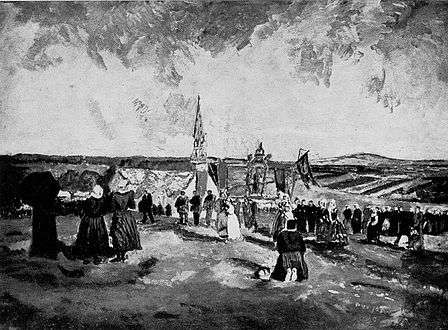Max Jacob
| Max Jacob | |
|---|---|
_-_1934_-_Foto_Carl_van_Vechten%2C_Library_of_Congress.jpg) Max Jacob, photographed by Carl van Vechten | |
| Born |
12 July 1876 Quimper, Finistère, Brittany |
| Died |
5 March 1944 (aged 67) Drancy Deportation Camp |
| Pen name |
Léon David Morven le Gaëlique |
| Nationality | French |
|
| |
| Signature |
|
Max Jacob (French: [maks ʒakɔb]; 12 July 1876 – 5 March 1944) was a French poet, painter, writer, and critic.
Life and career
| French literature |
|---|
| by category |
| French literary history |
| French writers |
|
| Portals |
|
After spending his childhood in Quimper, Brittany, France, he enrolled in the Paris Colonial School, which he left in 1897 for an artistic career. He was one of the first friends Pablo Picasso made in Paris. They met in the summer of 1901, and it was Jacob who helped the young artist learn French.[1] Later, on the Boulevard Voltaire, he shared a room with Picasso,[2] who remained a lifelong friend (and was included in his artwork Three Musicians). Jacob introduced him to Guillaume Apollinaire, who in turn introduced Picasso to Georges Braque. He would become close friends with Jean Cocteau, Jean Hugo, Christopher Wood and Amedeo Modigliani, who painted his portrait in 1916. He also befriended and encouraged the artist Romanin, otherwise known as French politician and future Resistance leader Jean Moulin. Moulin's famous nom de guerre Max is presumed to be selected in honor of Jacob.
Jacob, who had Jewish origins, claimed to have had a vision of Christ in 1909, and converted to Catholicism.
Max Jacob is regarded as an important link between the symbolists and the surrealists, as can be seen in his prose poems Le cornet à dés (The Dice Box, 1917 – the 1948 Gallimard edition was illustrated by Jean Hugo) and in his paintings, exhibitions of which were held in New York City in 1930 and 1938.
His writings include the novel Saint Matorel (1911), the verses Le laboratoire central (1921), and Le défense de Tartuffe (1919), which expounds his philosophical and religious attitudes.
The famous psychoanalyst Jacques Lacan attributed the quote "The truth is always new" to Jacob.[3]
Death
Having moved outside of Paris in May, 1936, to settle in Saint-Benoît-sur-Loire, Loiret, Max Jacob was arrested on 24 February 1944 by the Gestapo, and interned at Orléans prison, (prisoner #15872).[4] Jewish by birth, Jacob's brother Gaston had been previously arrested in January, 1944, deported to Auschwitz concentration camp, and gassed upon arrival with his sister Myrthe-Lea; her husband also deported and murdered by the Nazis. Following his incarceration at Orléans, Max was then transferred to Drancy internment camp from where he was to be transported in the next convoy to Auschwitz in Poland. However, said to be suffering from bronchial pneumonia, Max Jacob died in the infirmary of Le Cité de la Muette, a former housing block which served as the internment camp known as Drancy[5] on 5 March.[6]
First interred in Ivry, after the war ended in 1949 his remains were transferred by his artist friends Jean Cassou and René Iché (who sculpted the tomb of the poet) to the cemetery at Saint-Benoît-sur-Loire in the Loiret département.
Pseudonyms
As well as his nom d'état civil, or regular name, Jacob worked under at least two pseudonyms, Léon David and Morven le Gaëlique.
Gallery
 "Le pardon de Sainte-Anne".
"Le pardon de Sainte-Anne". "Le clocher de Ploaré".
"Le clocher de Ploaré". "Le marché à Pont-l'Abbé".
"Le marché à Pont-l'Abbé".- "Le calvaire de Guengat". A Max Jacob painting held in Quimper's Musée des beaux-arts.
See also
- Lionel Floch
- Furniture music: Erik Satie's second set of furniture music was composed and performed in 1920 as Entr'acte music for one of Jacob's comedies (Ruffian toujours, truand jamais – text of this play is lost)
- The Selected Poems of Max Jacob, trans. William Kulik (Oberlin College Press, 1999), ISBN 0-932440-86-X
- Monsieur Max (2007), French TV movie starring Jean-Claude Brialy as Jacob, in Brialy's last film role
References
- ↑ McNeese, Tim (2006). Pablo Picasso. p. 33. ISBN 1438106874.
- ↑ Jacob, Max (1991). Green, Maria, ed. Hesitant fire: selected prose of Max Jacob. p. xvi. ISBN 0803225741.
- ↑ Lacan, Jacques (2008) My Teaching, Verso Press.
- ↑ http://www.max-jacob.com/collections.html
- ↑ The French poet Nicolas Grenier has written a tribute poem to a Max Jacob.
- ↑ Caws, Mary Ann (2004). Yale Anthology of 20th-century French Poetry. Yale University Press. p. 47. ISBN 978-0-300-10010-5.
External links
 Media related to Max Jacob at Wikimedia Commons
Media related to Max Jacob at Wikimedia Commons- Marevna, "Homage to Friends from Montparnasse" (1962) Top left to right: Diego Rivera, Ilya Ehrenburg, Chaim Soutine, Amedeo Modigliani, his wife Jeanne Hébuterne, Max Jacob, gallery owner Leopold Zborowski. Bottom left to right: Marevna, Marika (Marevna and Diego Rivera's daughter), Moise Kisling.
- Association les Amis de Max Jacob
- English translations from Max Jacob's major collection of prose poetry The Dice Cup
- Max Jacob at Find-A-Grave